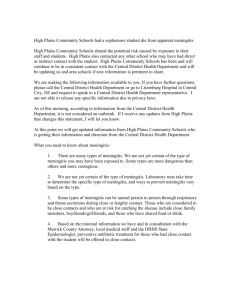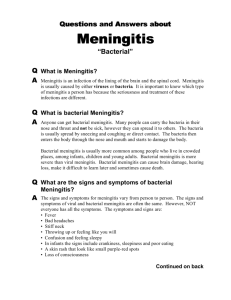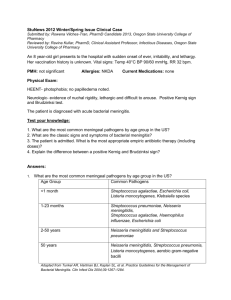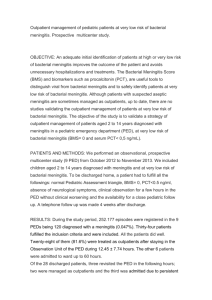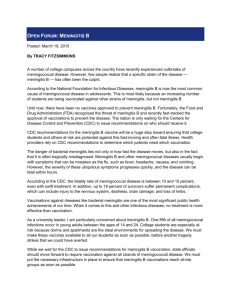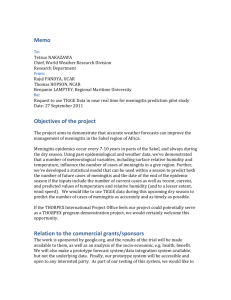1.1.6 Final Diagnosis Report An Outbreak at the
advertisement
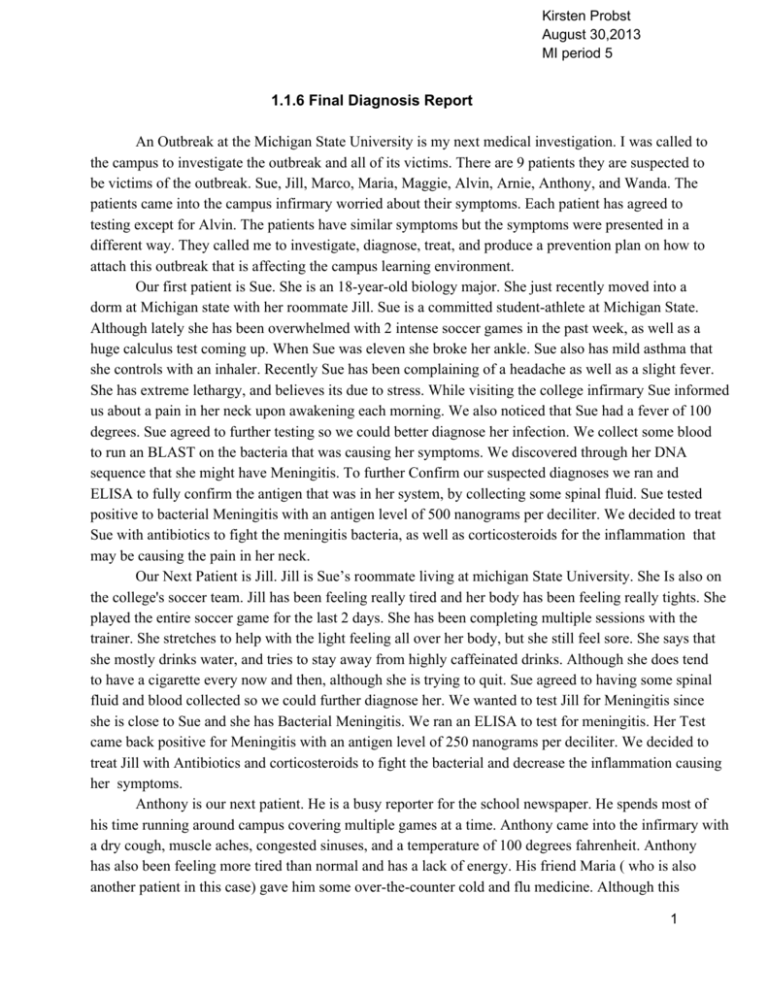
Kirsten Probst August 30,2013 MI period 5 1.1.6 Final Diagnosis Report An Outbreak at the Michigan State University is my next medical investigation. I was called to the campus to investigate the outbreak and all of its victims. There are 9 patients they are suspected to be victims of the outbreak. Sue, Jill, Marco, Maria, Maggie, Alvin, Arnie, Anthony, and Wanda. The patients came into the campus infirmary worried about their symptoms. Each patient has agreed to testing except for Alvin. The patients have similar symptoms but the symptoms were presented in a different way. They called me to investigate, diagnose, treat, and produce a prevention plan on how to attach this outbreak that is affecting the campus learning environment. Our first patient is Sue. She is an 18­year­old biology major. She just recently moved into a dorm at Michigan state with her roommate Jill. Sue is a committed student­athlete at Michigan State. Although lately she has been overwhelmed with 2 intense soccer games in the past week, as well as a huge calculus test coming up. When Sue was eleven she broke her ankle. Sue also has mild asthma that she controls with an inhaler. Recently Sue has been complaining of a headache as well as a slight fever. She has extreme lethargy, and believes its due to stress. While visiting the college infirmary Sue informed us about a pain in her neck upon awakening each morning. We also noticed that Sue had a fever of 100 degrees. Sue agreed to further testing so we could better diagnose her infection. We collect some blood to run an BLAST on the bacteria that was causing her symptoms. We discovered through her DNA sequence that she might have Meningitis. To further Confirm our suspected diagnoses we ran and ELISA to fully confirm the antigen that was in her system, by collecting some spinal fluid. Sue tested positive to bacterial Meningitis with an antigen level of 500 nanograms per deciliter. We decided to treat Sue with antibiotics to fight the meningitis bacteria, as well as corticosteroids for the inflammation that may be causing the pain in her neck. Our Next Patient is Jill. Jill is Sue’s roommate living at michigan State University. She Is also on the college's soccer team. Jill has been feeling really tired and her body has been feeling really tights. She played the entire soccer game for the last 2 days. She has been completing multiple sessions with the trainer. She stretches to help with the light feeling all over her body, but she still feel sore. She says that she mostly drinks water, and tries to stay away from highly caffeinated drinks. Although she does tend to have a cigarette every now and then, although she is trying to quit. Sue agreed to having some spinal fluid and blood collected so we could further diagnose her. We wanted to test Jill for Meningitis since she is close to Sue and she has Bacterial Meningitis. We ran an ELISA to test for meningitis. Her Test came back positive for Meningitis with an antigen level of 250 nanograms per deciliter. We decided to treat Jill with Antibiotics and corticosteroids to fight the bacterial and decrease the inflammation causing her symptoms. Anthony is our next patient. He is a busy reporter for the school newspaper. He spends most of his time running around campus covering multiple games at a time. Anthony came into the infirmary with a dry cough, muscle aches, congested sinuses, and a temperature of 100 degrees fahrenheit. Anthony has also been feeling more tired than normal and has a lack of energy. His friend Maria ( who is also another patient in this case) gave him some over­the­counter cold and flu medicine. Although this 1 Kirsten Probst August 30,2013 MI period 5 seemed to have no effect except for it relieved some of his sinus congestion. So we decided to run a ELISA on the patient to test for meningitis since it seemed to be common. Although the test was negative and we were able to rule out Meningitis. So we ran a BLAST on Anthony’s blood to identify the DNA sequence for the bacteria and diagnose him. The BLAST identified the bacteria as the Influenza B Virus, also known as the Flu. To treat the flu we recommended he take acetaminophen to decrease the fever and help with the muscle aches. Then we prescribed some antiviral medications to fight the virus. We also recommended that he get lots of rest and drink lots of fluids. Another Patient of ours is Wanda. Wanda lives on campus and is pledging to the same sorority as Jill. She has noticed that the glands in her throat are swollen and she has been waking up with a sore throat. She has also had a fever for the past few days. Wanda’s boyfriend, Ray, has the same symptoms as Wanda but refuses to go to the doctor. Although wanda has not seen Ray as much lately. We Collected Some spinal fluid to run an ELISA on the bacteria that was making her sick. We wanted to test her for Meningitis just to be safe. Although her test results were negative and Wanda does not have meningitis. So we ran a BLAST on her blood to identify the bacteria completely. The DNA sequence from the bacteria told us that Wanda had the Human Herpesvirus 4 strain, which is also known as Mononucleosis. There is no set treatment for Mono except for lots of rest and plenty of fluids. To help with the sore throat we prescribed a streptococcal. Our next patient is Maggie. Maggie is the lead singer in a popular band on campus, which made her come to the infirmary when her throat grew increasingly scratchy. She has been drinking tea and gargling salt water to help with the irritation. Maggie’s head has been feeling heavy lately and she has not been able to regulate her temperature.She’s been having random hot and cold flashes. We test Maggie for meningitis by running an ELISA, as well. Although her test results came back negative for bacterial meningitis. So we took some blood and ran a BLAST. By identifying the bacteria's DNA sequence we were able to tell that Maggie has Strep. So she will just take antibiotics for up to 10 days to clear the bacteria out of her system.Then she should be back to singing in her band on campus as soon as possible. The next patient is Maria. She is a very close friend of Sue and Jill and is over there all the time. She is always eating their food and drinking from their glasses. Lately Maria has been feeling run down, like she has no energy. Maria doesn't like doctors so she has been trying to put off going to the doctors as long as possible. But when she woke up feeling like her head was on fire, so she decided to come to the college infirmary. She was barely able to get out of bed and we found out that she has fever of 103 degrees. Since she had a high fever like Sue and Jill we figured that we should test her for meningitis to be safe. So we ran an ELISA on some spinal fluid we had collected, and discovered that she did test positive for bacterial meningitis. Maria had a antigen concentration of 25 nanograms per deciliter. TO treat her we prescribed some antibiotics and corticosteroids. Another patient is Arnie. Arnie is a photography student at the college that loves to take pictures of the athletic events at school. Some of his pictures have been feature in the school newspaper.Which Anthony, a friend who lives on the same floor as Arnie, is helping Arnie pick which ones to submit. Arnie said he has been struggling with a cough and a runny nose for the past few days. 2 Kirsten Probst August 30,2013 MI period 5 He tried increasing his vitamins to decrease the spread of the infection, but the infection still got worse. The night before he came into the infirmary he could not stop coughing while on the phone with his girlfriend. When Arnie came to the infirmary he had a fever of 100.5 degrees. Just like all the other patients Arnie was tested for meningitis through as ELISA test. Although Arnie also tested negative for meningitis. So we ran a BLAST on his blood to better diagnose him. Through the BLAST we found that Arnie had the influenza B virus, also known as the Flu. Since the flu can not be treated with medication. We told Arnie to make sure he got lots of rest and drinks plenty of fluids. Then some over­the­counter cough and cold medication to help the body fight the bacteria. Our next Patient was Marco. Marco would love to go home for the holidays but fears that whatever he has he will pass on to his girlfriend, Elena. Marco is Sue’s lab partner in biology. They spend almost 4 hours together twice a week, and have grown to be good friends. They tend to sneak food into the lab to eat during the breaks and they share with each other. When Marco came into the infirmary he was complaining of extreme fatigue and strong headache. Marco thinks it is a cold, but since him and sue spend large amounts of time together we tested him for meningitis just to be safe. We ran an ELISA on Marco’s spinal fluid and discovered that he tested positive for bacterial meningitis. He had an antigen concentration of 10 nanograms per deciliter. We hope that since we caught it early if we send him home with some antibiotics and corticosteroids he will be able to go home for the holidays. Our last patient is Alvin. Alvin is a guitar player, and has recently become involved with some bands on campus. He has had a lack of sleep this past week due to a major chemistry test he is studying for. Alvin has been complaining of a headache and sore throat. Although Alvin believes that his soreness is from his enthusiastic yelling at a concert the night before coming to the infirmary. We wanted to test Alvin for meningitis using an ELISA, and found that he test negative for meningitis. So we wanted to run a BLAST on his blood but Alvin refused to any further testing and we were unable to get a completely accurate diagnoses. Although we did notice that as Alvin was leaving the infirmary Wanda met him with a hot cup of coffee. From what we can infer we believe Alvin has Mononucleosis. We believe that when Wanda greeted him with the coffee that they might know each other already and be good friends. So we believe that Wanda and Alvin might have used the same water fountain like one right after the other, or shared a cup, or something where the bacteria could be transmitted. So if this is the case we should look into Alvin and Wanda’s relationship to better the diagnoses. Although since there is no definite treatment we will just recommend that he get plenty of rest and drink plenty of fluids. We will also give him a streptococcal for the sore throat. We suspected the Flu and meningitis for almost all the patients. So we decided to test for meningitis first. We first tested Sue for meningitis because she was our first patient. We found that Sue did infact have bacterial meningitis. So we needed to test the rest of the patients that might have come into contact with Sue in the last week. So we began to track the connection between each patient. We knew that Sue and Jill where roommate so next we tested Jill, and she came up positive for meningitis. Then our next patient was Anthony who had no connection to Sue and Jill except for when he might have covered one of their soccer games.Although Anthony is good friends with Maria who is always over at Sue and Jills dorm room. So we tested Maria for meningitis and discovered she did have 3 Kirsten Probst August 30,2013 MI period 5 meningitis, which made us test Anthony who came up negative. So we tested all the patients for bacterial meningitis. and found that Sue, Jill, Maria, and Marco had bacterial meningitis. So from the ELISA tests we found that Sue had the highest concentration of the meningitis antigen. So we believe that the path of infection starts with her. Jill had the second highest,then Maria, the Marco. We Also thought that marco might have started it, since his antigen concentration was so low he might have been at the end of his illness. Then we notice that marco had said that he wanted to treat whatever he had as soon as possible before he got worse. So we believe that he was at the end of his illness. Therefore Marco was the last patient to be infected. The next infection that was diagnose was the Flu. Both Arnie and Anthony had the Influenza B virus. Which I believe that it started with Arnie, because he said he had been dealing with the symptoms for the past week. Then next infection was Mononucleosis. Wanda was diagnosed with mono from her symptoms and a BLAST that we ran on her blood. She also said that her boyfriend had all the same symptoms and they both refused to go to the doctors for a little while. Then I also believe that Alvin has mono as well, but we are not 100% sure. He refused to be tested but we notice that after his doctors appointment that wanda met him with a cup of coffee. Now we believe that they have come into contact before and he might have got it from her. Then the last illness is strep which only Maggie was diagnosed with. During the diagnoses we obtained spinal fluid from all the patients to run an ELISA. Then we obtained blood from all the patients except for Sue, Jill, Maria, and Marco to run a BLAST. When we ran the ELISA we took the sample and extracted the antigens DNA to identify it by mixing it with a specific antibody. By extracting the DNA we were able to combine antigen specific antibodies to bind to the antigen in the sample DNA and identify the infection. We tested the patients for meningitis using the meningitis antibody. When we ran the BLAST we obtained blood from each of the remaining patients that didn’t test positive for meningitis during the ELISA. The BLAST takes the blood sample and extracts the bacteria from it. It takes the bacterial sample and separates the bacteria’s DNA from it. It amplifies the DNA’s PCR then purifies it. Then It separates the DNA band from the rest of the Sample and sequences it.This puts the DNA into the A,C,T,G, sequence. This sequence can then be analyzed and can be paired with the DNA’s of other bacteria in the system already. Thus identifying the infection in each patient. ELISA stands for Enzyme­Linked Immunosorbent Assay. In an ELISA the person running the test will first make serial dilution wells, so they have something to compare the patient test to. In this they will decrease the amount of antigen in each well to show different levels of concentration when the whole experiment is done. To test the patient, they will place the patient sample (spinal fluid) into the wells. Where the antigen and DNA will bind to the walls of each well. Then the will add a primary antibody that will bind to the specific antigen is it supposed to bind too. Then will add a secondary antibody that will amplify the antigen by binding to the primary antibody. Next they will as the enzyme substrate to the wells where the enzyme will link to the secondary antigen, then later catalyse with the whole chain causing the leftover liquid to turn a different color letting you know if the patient is positive or negative for that infection. All while washing out the wells in between each step. Once the experiment is over, thats when the serial dilution wells (“test­strip”) come in handy.YOU see once you calculate the 4 Kirsten Probst August 30,2013 MI period 5 serial dilution in each well,you can then compare it to the patient test, which allows you to know if they are positive or negative and the dilution or antigen level that is found in the patients body. This allows for a better diagnosis of an outbreak. Although the only problem is that the testis antigen and antibody specific, so you need to know what you are testing for. Which is why this test was very helpful in this outbreak. We had suspected meningitis in many of the patients, so it made more sense to test all the patients for meningitis. So we did and found that Sue had it so we tested all the other patients and found that 3 other patients as well. Which helped up discover the diagnoses of 4 patients and help us get to treatment and prevention as fast as possible. We found that collecting spinal fluid and testing patients using the ELISA test is more effective and more efficient when diagnosing for bacterial meningitis. So to further test for meningitis in other patients, we will run an ELISA so we can try and catch the disease as soon as possible. For the patients that do test positive for bacterial meningitis, we will treat them with some antibiotics and a corticosteroid for the inflation that meningitis can bring on. Cefotaxime is the antibiotics we will be using to treat the patients who tested positive for bacterial meningitis. This antibiotic better fights the bacteria and it better crosses the blood­brain barrier when fighting the bacteria. Then we have to prevent this bacteria from spreading. So we are to going to vaccinate all the patients that we tested the came up negative for bacterial meningitis with Meningococcal conjugate vaccine (MCV4 or Menactra). This is the most effective vaccine is patients between the ages of 2­55. The reason we are doing this is because if the patients have not been vaccinated before and they are currently sick from another infection, it makes them highly susceptible to bacterial meningitis. So it is important that they get vaccinated. Next we are going to ask that all the students on campus who have not been vaccinated for bacterial meningitis yet, be vaccinated this way we can stop the spread of infection and further prevent another outbreak of bacterial meningitis. Citations: ● Mason, M. (2012, November 4). Flu. Retrieved from The New York Times website: http://health.nytimes.com/health/guides/disease/the­flu/overview.html ● Mayo Clinic Staff. (2012, December 19). Mononucleosis. Retrieved from Mayo Clinic website: http://www.mayoclinic.com/health/mononucleosis/DS00352/DSECTION=treatments­and­drug s ● (2012, March 15). Bacterial meningitis. Retrieved from CDC website: http://www.cdc.gov/meningitis/bacterial.html ● Cefotaxime. (2013, August 15). In Wikipedia, The Free Encyclopedia. Retrieved 19:01, September 2, 2013, from http://en.wikipedia.org/w/index.php?title=Cefotaxime&oldid=568704104 ● Rothman, J. (2011, August 30). Vaccination for bacterial meningitis. Retrieved from everyday Health website: http://www.everydayhealth.com/meningitis/vaccination.aspx 5
